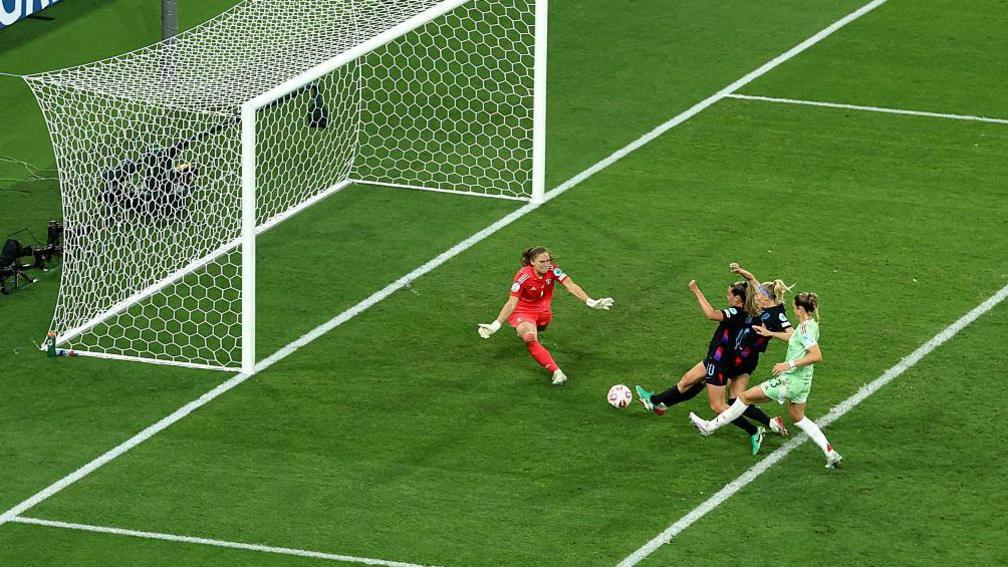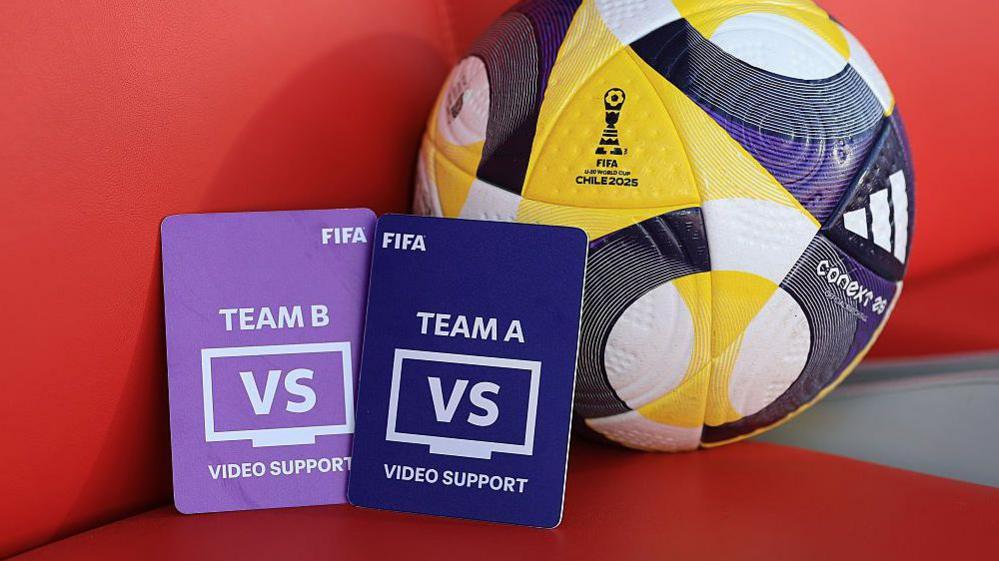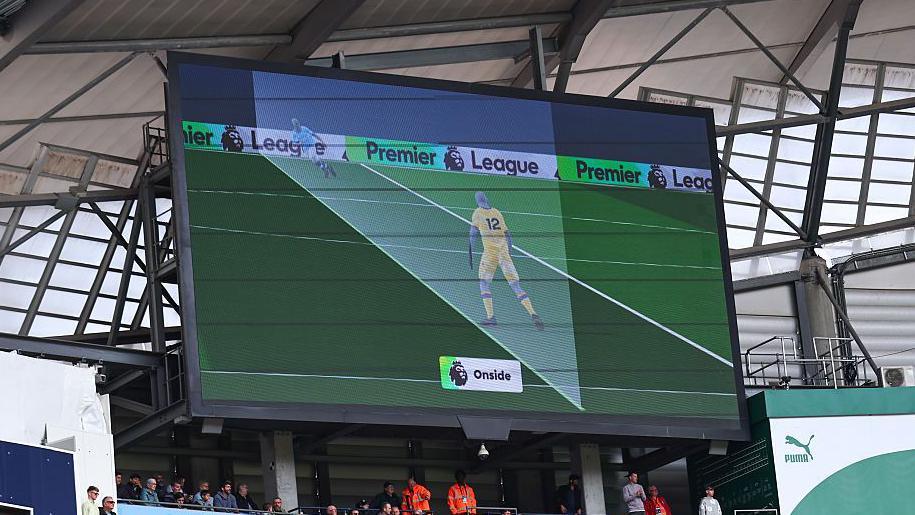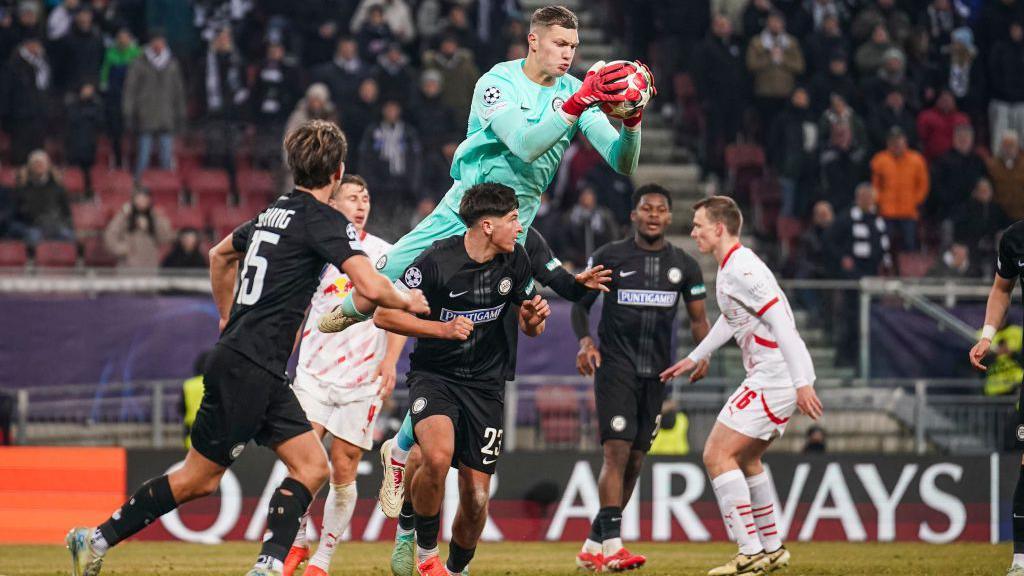What if pundits could change one thing about football…
Dale JohnsonFootball issues correspondent
- 11 minutes ago
Imagine a world in which you could reinvent football.
It’s a dream, of course. Just a bit of fun. But stick with us.
What if you had the power to change any of the game’s laws and potentially bring to an end countless hours of discussion about handball, offside, video assistant referees, or anything else you want to?
In that spirit, we asked players, pundits and even referees what football could look like if we ripped up the rulebook and started afresh.
Think of it as a manifesto for reinventing the game so many of us love.
Here’s what we came up with…
Penalties: Make the punishment fit the crime
Think here about that relatively innocuous trip as an attacker is moving away from goal – or a handball decision when there’s no immediate likelihood of a goal.
The result? A penalty – and a very high chance of a goal (historically, Opta says, 78%) when no such opportunity existed.
Is it fair, for example, that Brentford were given such a high chance of scoring when Liverpool defender Virgil van Dijk tapped the boot of Dango Ouattara right on the edge of the 18-yard area last month?
Is a shot from 12 yards with only the goalkeeper to beat a just punishment?
We already define an obvious goalscoring opportunity for a red card, so we’d only have to tweak this to any kind of scoring chance for a penalty.
If it’s a foul with no clear attacking impact, why not a free-kick?
Could this incentivise defenders to bring opponents down in areas where a penalty would not be the result? Any deliberate or cynical act would still result in a spot-kick.
Penalties: One and done – no more rebounds

Goals scored from rebounds on penalties have produced exhilarating, match-defining moments
Imagine when a penalty is saved or hits the woodwork and bounces back into play that the game is stopped and the ball given to the goalkeeper.
Pierluigi Collina – perhaps the most famous football referee of all time, and now head of Fifa’s referees’ committee – is already on board.
Collina argues that if the attacking team have squandered such a big chance of scoring, why should they be allowed a second or even third opportunity?
In recent campaigns an average of just under three goals a season have been scored in such circumstances, so is it really that important?
And would we want to risk losing some of the game’s most memorable moments?
Think Chloe Kelly’s 119th-minute goal for England against Italy in the semi-final of Euro 2025. Or Liverpool’s Xabi Alonso netting at the second attempt against AC Milan in their dramatic comeback in the second half of the 2005 Champions League final. Or Harry Kane’s winning goal for England against Denmark at Euro 2020.
If this adaptation was made, the look of the pitch could change, too – because the ‘D’ at the edge of the penalty area to keep players 10 yards away from the ball at a spot-kick would no longer be needed.
VAR: Bring in a challenge system

Football Video Support – a Fifa-trialled challenge system – gives each team two chances to request a review of a referee’s decision
Will VAR ever be accepted? Perhaps not in its current form, so how about adapting it to a challenge system?
You might not have heard of Fifa’s Football Video Support (FVS), which is being trialled in several leagues including Liga F – the top flight of the women’s game in Spain.
Under FVS, a coach is given two challenges per game. When they are activated, the on-field referee goes to the monitor to watch the incident back and make a decision. There isn’t a VAR poring over the footage, just a replay operator to show the incident to the referee.
Everton and England goalkeeper Jordan Pickford likes the theory.
“With VAR involved, I’d do it like cricket,” Pickford said. “They’ve got two decisions and the captain has got to make sure they review at the right time, in so many seconds. I think that would keep the speed of the game up, and keep it flowing.”
Sound good? It has its merits. The assumption is there will be better final outcomes, though trials have shown that’s not always the case, and mistakes are still made by a referee at the screen.
Match of the Day presenter Gabby Logan thinks there’s a different way of doing it.
“It’s to have a time limit on VAR,” she said. “We all agree now it’s here to stay, and it often does good things, but the time it can take is tiresome. It stops the game. People get angry with it.
“If it was 90 seconds only, I think we’d sort a lot of that out because if it’s not clear and obvious in 90 seconds, it’s not clear and obvious.”
But for former England defender Stephen Warnock, the solution is simpler – get rid of VAR.
“I’m fed up of players not celebrating goals, the fans not knowing what’s going on in the stadium, and there’s far too many inconsistencies with it and it’s down to human error which is still a massive problem,” he said.
Reimagining Football
Tuesday, 11 November from 21:30 GMT
VAR offsides: Lose the microscopic tech

In Major League Soccer, offside decisions are made with the naked eye. In the Premier League, fans are shown an image which is often unclear
The concept of offside is very different from its first iteration in 1863 when – a little bit like rugby – you were offside if you were in front of the ball.
Three years after its introduction, the law changed to consider the position of the defenders closest to their own goal, and it hasn’t altered much since.
But the initial idea surely wasn’t that players should be penalised for having a toe in front of the ‘offside line’? After all, you only had the judgement of the assistant.
We’re told VAR tech is uber-reliable, but we’re in the hands of AI and a VAR who has to manually confirm a frame that might not be the exact point the ball has been played anyway. And how confusing can those animations be?
So, how about ditching the microscopic tech, and just relying on a TV picture with no lines or funky graphics and an official’s eye?
That’s how it’s done in Major League Soccer – largely because of problems with wildly differing stadium configurations.
The VAR looks at the images and decides if it’s possible the assistant has got the decision wrong. If so, the referee is sent to the monitor to look. In other words, MLS judges offside at the clear and obvious threshold and not to millimetres.
Would TV companies still draw their own lines? Probably, which would undoutedly mean the controversy around offside decisions would not dissipate.
Premier League referee Anthony Taylor had a more radical suggestion.
“One of the best tournaments I refereed in was a prison officer tournament and we had no offside… and we had so many goals it was unbelievable,” he said.
“So maybe scrapping offside might be the answer.”
Handball: Make it like it used to be
If you asked a football fan to define handball a decade ago, you’d get a simple answer, like: “Ball to hand isn’t a penalty.”
Put that question to them today, and they probably wouldn’t know where to start.
Former England captain Alan Shearer pointed to some of the phraseology that has come into the football lexicon around handball as he called for change.
“Proximity… obvious position… not in an obvious position… natural,” he said. “For me, it’s pretty simple – is it deliberate handball or not?”
Some of the confusion has come from a big rewrite of the lawbook in 2019, when the considerations for handball went from just three lines to an entire page.
Referees were served with a whole menu of reasons to give handball.
The aim was to give a “clearer and more consistent definition and interpretation”. What it brought was consistently more penalties, because there were many more reasons to give one.
The micro-definition of handball has left people guessing, so how about getting back to basics? Let the referee make handball decisions how they used to – on instinct.
Stop the clock when the ball goes out
This idea has been kicking around for many years, with the intention that if the watch is stopped, teams can’t waste time.
The plan could be for each half to last 30 minutes, with the clock halted when the ball isn’t in play. That guarantees 60 minutes of effective playing time, and means much of the incentive to take vital seconds out of the match is removed.
Fans would actually gain rather than lose out, too, with the average ball-in-play time this season 55 minutes 05 seconds – 114 seconds down from last season.
It’s not a magic bullet, because teams who are looking to see out a lead – or hold on to a draw – could still go slowly to break up the momentum of the opposition.
And if the clock is going to stop, how long will it take to play 60 minutes? There’s no clear footprint for the match. The average 60-minute NFL game takes more than three hours to complete.
Introduce tactical timeouts
For this, we turn to former Wales captain Ashley Williams.
“I would give each team at least one timeout per half, and you can use that whenever you want,” he said.
“It might be before a corner, before a free-kick, if someone’s injured. If the manager needs to get hold of their team and change something, I’d let them have a timeout like they do in other sports.”
The modern trend seems to be for teams to secure themselves an ‘unofficial’ tactical timeout by telling a goalkeeper to go down injured, though we should point out – for the avoidance of doubt – that sometimes goalkeeper injuries are genuine!
As the physio runs on, all of the outfield players head over to the technical area for a team talk. When the manager has passed on his key messages, the goalkeeper is often fine to play on.
This little interlude can change the direction of a game, and adversely impact the opposition. While they have the chance to speak to their manager too, it often is the case that they don’t need to change anything, so any team talk has less impact.
Would an allocated tactical timeout stop this? In some cases, but not all.
So how about banning players from going over to the touchline as a group? Or if a goalkeeper needs attention from a physio, their team has to nominate an outfield player to go off for 30 seconds instead?
Bring in bonus points – and punish 0-0 draws
Arsene Wenger, when he was manager of Arsenal, often spoke about giving teams extra points to award attacking play.
It never caught on widely, though he did get his way in the pre-season Emirates Cup in the summer of 2009. There, clubs were awarded three points for a win plus an extra point for every goal scored.
Former Manchester City defender Nedum Onuoha is thinking along the same lines.
“I like the idea of a bonus point for every time you score two goals,” he said. “Instead of just getting three points, you score two goals and that’s four points. You score four goals, that’s five points.
“From an attacking perspective, you can really start to climb the ladder. You’ll see more goals in the league, which means fans would be more entertained.”
There’s another option.
Former Barcelona and Manchester United defender Gerard Pique flipped the logic earlier this year by suggesting teams should get zero points if a match ends 0-0.
Pique believes boring games would explode into life for the final 20 minutes because a 0-0 draw would give teams as many points as a 1-0 defeat.
The counterpoint is there could times it would be more advantageous to take the same points as the opposition – even if that’s zero – rather take a risk and be three worse off.
Let players take quick free-kicks to themselves
Consider these two scenarios: a player is breaking forward and is brought down by a tactical foul, or a goalkeeper comes out of his area and boots the ball into the crowd.
Play often can’t restart instantly, because a team needs to set up. But what if a player could take a free-kick, throw-in or corner to themselves and run with the ball?
It might seem a little out there, but it would make the game faster and might even bring more goals.
Former England midfielder Danny Murphy said: “It’s your advantage, you’ve got the ball, so why do you have to pass it to somebody else so you can get the game going quickly?”
Murphy also had a more radical suggestion, saying if anyone is caught cheating or diving, the other team should be awarded an automatic penalty.
Make the goals bigger

At 6ft 9in, Kjell Scherpen set a record as the tallest goalkeeper to play in the Premier League when he was at Brighton
In 1996, former Fifa president Sepp Blatter wanted to increase the size of football goals by 50cm in width and 25cm in height, but didn’t have enough support.
Is it time to look again?
The size of the goals – 24ft wide and 8ft high – hasn’t changed in 150 years.
But the average height of people has increased in that time, which would suggest goalkeepers are now at an advantage.
There are two sides to this, though.
In 1875, footballs were made of hand-stitched leather, often weighed down by the rain. Today they are lightweight and made of synthetic leather and designed to aid movement through the air.
Goalkeepers would argue that any advantage they have is only matched by the evolution of the ball and the athleticism of outfield players. Do attackers really need more goal to aim at?
Related topics
-
- 17 October

-
- 16 August
